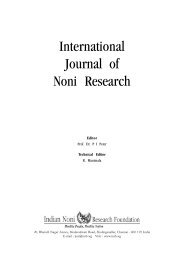International Journal of Noni Research - Noni Family
International Journal of Noni Research - Noni Family
International Journal of Noni Research - Noni Family
You also want an ePaper? Increase the reach of your titles
YUMPU automatically turns print PDFs into web optimized ePapers that Google loves.
D.R. Singh<br />
R.C. Srivastava<br />
Subhash Chand<br />
Abhay Kumar<br />
Authors’ affiliation :<br />
D.R. Singh<br />
R.C. Srivastava<br />
Subhash Chand<br />
Abhay Kumar<br />
Central Agricultural <strong>Research</strong> Institute<br />
Indian council <strong>of</strong> Agricultural <strong>Research</strong><br />
Port Blair<br />
Andaman and Nicobar Islands<br />
India - 744 101.<br />
Correspondence to :<br />
D.R. Singh<br />
Central Agricultural <strong>Research</strong> Institute<br />
Indian council <strong>of</strong> Agricultural <strong>Research</strong><br />
Port Blair, Andaman and<br />
Nicobar Islands<br />
India - 744 101.<br />
drsingh1966@yahoo.com<br />
45 Intl. J. <strong>Noni</strong> Res. 2007, 2(1-2)<br />
Morinda citrifolia L. – An evergreen<br />
plant for diversification in commercial<br />
horticulture<br />
Keywords : Morinda citrifolia, CARI, Port blair, phendogical traits, propagation,<br />
Tsumani, Physico-chemical properties, economics.<br />
Abstract : Morinda citrifolia L. var. citrifolia, the commonly called<br />
<strong>Noni</strong> in India and also known as the Indian Mulberry is one <strong>of</strong> the<br />
important plants <strong>of</strong> Rubiaceae family. <strong>Noni</strong>’s broad proliferation gives<br />
testimony to its value to traditional cultures. In Andaman and Nicobar<br />
Islands, it is widely found throughout the coastal region and also along the<br />
fences and the roadsides due to its wide adaptability to hardy environmental<br />
and soil conditions. The whole plant ie. leaf, stem, root and fruits is<br />
known to be <strong>of</strong> commercial importance. The tribes <strong>of</strong> these islands are<br />
known to consume this fruit in raw form with common salt as well as<br />
cooked vegetables. After Tsunami disaster, it has been found that Morinda<br />
is the only plant <strong>of</strong> commercial value, which is surviving in affected lands<br />
turned wastelands due to sea water intrusion. Studies at CARI, Portblair,<br />
were initiated to evaluate the full potential <strong>of</strong> this plant. It has been found<br />
that this plant can be used for rehabilitating the livelihood <strong>of</strong> farmers<br />
affected by Tsunami. It survives in sea water inundated saline soils and in<br />
all kinds <strong>of</strong> soil in Andaman and Nicobar Islands. This plant can also<br />
come up under 50 percent shade and therefore can be grown as<br />
intercrop. The canopy coverage provides very good cover to soil resulting<br />
in reduction in soil and run<strong>of</strong>f losses. The annual yield <strong>of</strong> Morinda fruits<br />
per tree initially is 10 kg /tree in the third year by harvesting 5-8 times<br />
in a year and it increases to 100 kg/ year after 6 years.<br />
With fruit juice being used for manufacturing health enhancer, its<br />
cultivation assumes source <strong>of</strong> regular income and employment security.<br />
In addition, Morinda juice can be used as poultry feed supplement for<br />
immunity enhancement. Its leaves can also be used as mulch material.<br />
This paper presents a summary <strong>of</strong> the initial results <strong>of</strong> this study.<br />
Introduction<br />
Indian <strong>Noni</strong> plant (Morinda citrifolia L.) belongs to the family Rubiaceae.<br />
It is commercially known as <strong>Noni</strong>, and also known as Indian Mulberry,<br />
Cheese fruit, Yellow fruit, Pain killer, Nono etc.. It is a large shrub or a dwarf








